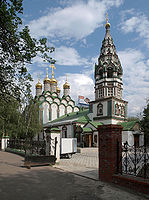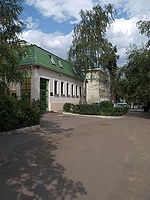- Church of St. Nicholas in Khamovniki
-
Church of Saint Nicholas in Khamovniki 
The church in 1880s
Basic information Geographic coordinates 55°43′55″N 37°35′29″E / 55.732039°N 37.591416°ECoordinates: 55°43′55″N 37°35′29″E / 55.732039°N 37.591416°E Affiliation Russian Orthodox State Russia Municipality Moscow Year consecrated 1682 Status Operational Heritage designation Federal listed building Architectural description Groundbreaking 1625 (first documental evidence) Completed 1682 (main church)
1694 (belltower)Church of Saint Nicholas in Khamovniki (Russian: Церковь Cвятителя Николая Чудотворца в Хамовниках) is a late 17th century parish church of a former weavers sloboda in Khamovniki District of Moscow. The church is a federal listed memorial building. It marks the corner of present-day Komsomolsky Prospect and Leo Tolstoy Street, two blocks beyond the Garden Ring. The church yard occupies a whole block between Leo Tolstoy and Timur Frunze streets and includes a row of small old houses.
History
First records of a presumably wooden church on this site are dated 1625. The main five-domed church was built in 1679-1682; belltower and refectory were completed around 1694. Present day church sources claim that the belltower in Khamovniki is one of the highest tent-style belltowers in Moscow region.[1] In 1757 the builders added a side annex dedicated to Saint Dmitry of Rostov.
The church is an example of late Muscovite Baroque that preceded short-lived Naryshkin Baroque of 1690s. It belongs to a numerous class of bonfire temples (Russian: огненные храмы) – church buildings without three internal load-bearing columns, crowned with layers of small circular kokoshnik-type gables. Each gable is a symbol of a heavenly fire (biblical thrones - angels or seraphs); a tightly packed group of gables is an architectural metaphore for the Throne of God. Small decorative columns "supporting" the lower level gables are an indicator of a Western influence in a typically vernacular building.
The church was severely damaged by the fire of 1812 and reopened only in 1849. Shortly before that, in 1848, the church acquired its principal relic - a copy of Defender of the sinners icon of Theotokos from Odrin convent, donated by Dmitry Doncheskul; the icon was permanently placed in the former Saint Dmitry annex. It also possesses 17th century icons of Saint Alexis and Hodegetria of Smolensk. In 2002 the church donated its icon of Archangel Michael to the reopened church of Archangel Michael in Devichye Pole.[2]
The church operates continuously singe 1849. It was never closed in the Soviet period although it lost its main bell (restored in 1992). It was restored externally twice, in 1949 and 1972. Father Pavel Lepekhin served here one of the longest continuous tenures in the 20th century Orthodoxy – from 1915 to 1960. Metropolitan Pitirim Nechaev (1926–2003), who was offered the tenure in Khamovniki in 1972, declined the offer: according to Pitirim, the congregation always filled the church beyond its capacity, making service exremely difficult physically even for young priests.[3]
Leo Tolstoy lived in the church parish, two blocks to the north on the street now bearing his name.



The tented belltower
of Khamovniki is one
of the highest of its type
in Moscow regionA row of small houses
in the church yardWorshippers of the icon Our Lady, protector of sinners References
- ^ (Russian) Church of Saint Nicholas in Khamovniki [1]
- ^ (Russian) Yelena Lebedeva. Tserkov svyatogo arhistratiga Mikhaila pri klinikah na Devichyem Pole (Елена Лебедева. Церковь святого архистратига Михаила при клиниках на Девичьем Поле) Pravoslavie.ru, 20.11.2006 [2]
- ^ (Russian) Pitirim Nechaev. Vospominania. (Митрополит Питирим. Воспоминания. Брюсовский храм) Pravoslavie, 30.12.2005 [3]
External links
Categories:- Churches in Moscow
- Buildings and structures completed in 1682
- Eastern Orthodox church buildings
Wikimedia Foundation. 2010.
